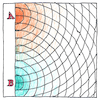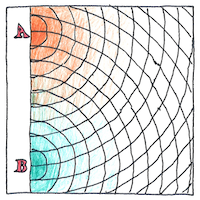Werner Heisenberg, Louis-Victor de Broglie,
Erwin Schrödinger
quantum mechanics

|
Wave-particle duality
Thomas Young showed light behaves like waves; Planck and Einstein showed it was made of particles. Quantum theorist Werner Heisenberg decided a mathematical solution based on matricies could serve instead of a physical description. Louis de Broglie insisted on a physical description— each particle of matter should physically also be a wave. No one has proven de Broglie’s hypothesis, but it inspired Ewin Schrödinger, whose wave function, describing a physical system evolving with time, shows what de Broglie’s idea looks like mathematically, plus Schrödinger’s equation can be transformed into Heisenberg’s matrix mechanics, and various solutions describe physical systems at any scale—molecular, atomic, and subatomic systems, even the universe itself.
Interference
Electrons, like photons, show an interference pattern after flying through two parallel slits. De Broglie thought that an electron has an internal clock that keeps it in synch with its propagation wave like other physical particles, showing more harmonic synchronization than our coarse senses can distinguish.
To explain
To say an electron is a wave is not to say it’s a particle that waves. When it’s a wave it’s not a particle, and when it’s a particle it’s not a wave; what we know as particle or wave is not the same as the electron itself. Even a simple zen kōan can stymie our expectations; we might never have evolved to understand anything’s true nature.



Einstein never managed to unify his general theory of relativity with quantum theory, but Schrödinger’s equation, because it includes the Hamiltonian operator, whose spectrum is the set of all possible energies of particles in a physical system and which takes different forms depending on the system, has been taken as a description of everything.
See also in The book of science:
Readings in wikipedia: